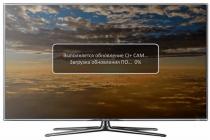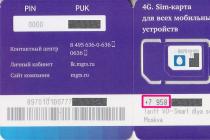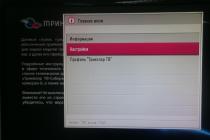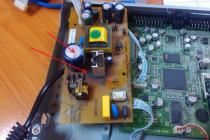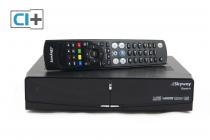In 2004, the French telecommunications company Alcatel-Lucent, or rather its division dealing with mobile devices, merged with a similar division of the Chinese company TCL Communication, creating a joint venture TCL & Alcatel Mobile Phones Limited (TAMP), where 55% of the shares belonged to TCL and 45 % - Alcatel-Lucent. All phone factories have been moved to China. And already in 2005, TCL completely bought out the shares of TAMP and renamed the company into TCT Mobile, concluding license agreement which allows it to manufacture phones under the Alcatel brand. The company is currently developing smartphones under the TCL and ALCATEL ONETOUCH brands for the markets of Asia, Latin America, Europe and other regions. She actively cooperates with large operators and distributors. TCL Communication ranks among the top ten fastest growing mobile phone manufacturers.
We are testing a smartphone that rightfully bears the title of flagship and meets all the canons of the market. The novelty can boast the latest platform MediaTek MT6592, 5-inch Full HD IPS-display, progressive Hi-Fi ES9018 audio decoder and a number of other equally interesting features, which we will consider in detail below. We suggest starting a review of new items with technical characteristics:
|
Manufacturer |
TCL Communication |
||
|
Type, form factor |
Smartphone, candy bar |
||
|
Communication standards |
850/900/1800/1900 MHz |
||
|
900/2100 MHz |
|||
|
High speed data transfer |
GPRS (32-48 Kbps), EDGE (236 Kbps), HSDPA + (up to 21.6 Mbps), HSUPA (up to 5.76 Mbps) |
||
|
SIM card type |
|||
|
CPU |
MediaTek MT6592: 8 ARM Cortex-A7 cores, up to 2 GHz, 1MB L2 cache |
||
|
Graphics adapter |
ARM Mali-450MP, up to 700 MHz |
||
|
IPS, 5 ", 1920 x 1080 pixels (440 ppi), touch, capacitive, multi-touch up to 10 touches, safety glass |
|||
|
RAM |
|||
|
Persistent memory |
|||
|
Card reader |
|||
|
Interfaces |
1 x 3.5mm audio mini-jack |
||
|
Multimedia |
Acoustics |
||
|
Sound processing |
Hi-Fi Decoder ES9018 and Headphone Amplifier Maxim9720 |
||
|
Microphone |
|||
|
The main |
13 MP, autofocus, electronic stabilization, face detection, LED flash, video recording in 1080p (30 FPS) |
||
|
Frontal |
2 MP, 1080p video recording |
||
|
Communication capabilities |
802.11 b / g / n (Wi-Fi Direct, Wi-Fi Hotspot, Wi-Fi Display) |
||
|
Proximity sensor, light sensor, LED indicator, G-sensor |
|||
|
Battery |
Li-ion: 2500 mAh |
||
|
Charger |
Input: 100 ~ 240VAC ex. at 50/60 Hz Output: DC 5V e.g. 1 A |
||
|
Electronic compass (E-compass) |
|||
|
140.4 x 69.1 x 7.9 mm |
|||
|
Operating system |
Android 4.2.2 Jelly Bean |
||
|
Official guarantee |
12 months |
||
|
Products webpage |
|||
Appearance, arrangement of elements
Generally speaking, the ALCATEL ONETOUCH IDOL X + smartphone has a rather pleasant, well-remembered appearance. First of all, this impression is due to the extremely small bezels around the display, the size of which is less than 2 mm on the sides and 14 mm at the top and bottom. In fact, they are a little thicker, given the black border, which is visible only when the screen is active, but that still does not change the essence. The smartphone is dominated by angular shapes with rounding at the extreme points.
A visual complement to the strict style is a one-piece plastic edging "like metal" (the lower half is chrome-plated, the upper half is polished), which encircles the body along the contour and thereby adds sophistication to the novelty. The concentric pattern on the back, radiating from the camera module, looks no less interesting.
In addition, the smartphone came out quite thin (7.9 mm) and light enough (only 125 g), although slightly longer than the LG Nexus 5. Therefore, despite the rather large diagonal of the display, it fits well in an average hand and does not feel bulky at all. The novelty is available in black and white colors.
The entire front of the smartphone is covered with tempered glass. The manufacturer on the official page indicates Corning Gorilla Glass 2 / NEG, but on the Internet there is also a mention of Asahi DragonTrail. Along its contour, there is a thin frame in the color of the case, which rises slightly above the glass.
Above the display are: a speaker mesh, a round LED event indicator, proximity sensors / lighting and a front camera. Under the display - three touch buttons, which are mirrored relative to the stock Android design: Back, Home (hold down to bring up Google Now) and Menu (hold down to call up the Launched Application Manager). They have a uniform white backlight and are displayed only when the screen is active. There is no way to adjust the brightness or duration of the backlight, but you can turn it off.
On the top there is a power / lock button and a universal audio jack (mini-jack 3.5 mm). The bottom end contains a micro-USB connector and two rather large perforated areas, under which, it would seem, are stereo speakers. However, there is only one speaker, and it is hidden under the left grill, while the main microphone is located under the right one.
Micro-SIM card slots covered with metal caps are symmetrically located on the side faces. Their fixation is carried out using magnets and is quite reliable. To open the plug, you need to click on the area with a special rounded bulge. On the right side, next to the SIM-card slot, there is a double volume rocker, which can be easily found blindly.
By the way, the smartphone is available in two versions: with one SIM card and support for microSD memory cards (model index 6043) and with two SIM cards, but already without support for memory cards (model index 6043D). In addition, the differences lie in the amount of internal memory: 16 GB for the first option and 32 GB for the second. Note that we got an engineering sample for testing, so the memory in it, despite the support for two SIM-cards, is only 16 GB.
On the non-separable back side there are: the main camera peephole, which barely rises above the body and has a chrome edging; one-section LED-flash (software flashlight is present) and mirrored logo ALCATEL ONETOUCH. The rest of the place is empty. Only at the bottom are the subtle technical and certification logos (white on a white background).
It should be noted that rear part the previous model (ALCATEL ONETOUCH IDOL X) was made of anti-fingerprint and scratch-resistant and more pleasant-to-touch matte plastic. The novelty is also made of less practical and somewhat slippery gloss, which actively collects prints and abrasions during active use (in a white model it is not so noticeable as in a black one).
In general, the smartphone looks nice and fits well in the hand, but the location of the power / lock button on the top end is somewhat inconvenient with such a display diagonal. Better, in our opinion, would be to place it on the right side, and the volume rocker on the left. And so every time you have to reach for this button or use one more hand.
In general, ALCATEL ONETOUCH IDOL X + is assembled very well: without any gaps and backlash. And thanks to the non-separable body, the novelty feels monolithic, does not bend and does not change its geometry under moderate torsion. Streaks appear on the display, but for this you need to press quite hard on the glass.
Smartphone ALCATEL ONETOUCH IDOL X + is equipped with a touch-sensitive IPS-matrix (produced by Sharp), made using OGS technology (no air gap between components), so that the image is as if on the surface itself. The display is protected by tempered glass, which has a relatively good oleophobic (grease-repellent) coating. In addition, thanks to this, a fairly good and easy sliding of the fingers is ensured and there is no accumulation of fingerprints, and those that appear are easily removed.
The 5-inch screen has a resolution of 1920 × 1080 (Full HD). At the same time, the pixel density is equal to 440 ppi, which is more than enough to display very smooth fonts and get a fairly detailed image in general. It is hardly possible to consider individual pixels, even with a strong desire.
The brightness of the display can be adjusted manually, or automatic regulation can be activated. The proximity sensor locks the screen when you bring your smartphone to your ear. The multitouch technology here allows you to process up to 10 simultaneous touches. In general, it shows very good sensitivity even to light touches (it does not respond to pressing with gloves).
In general, the display of ALCATEL ONETOUCH IDOL X + is very bright, quite contrasting, with maximum viewing angles and pleasant color reproduction. It should be noted that in the settings you can adjust the color temperature and saturation according to personal tastes. The maximum brightness is more than enough to view information on a bright sunny day, and the minimum brightness is more than enough for comfortable work in the dark, although the latter is somewhat higher than we would like. Summing up all of the above, we note that the display leaves a very pleasant impression and is an indisputable advantage of the novelty.
As already mentioned, the smartphone is equipped with only one speaker, which is located at the bottom. Thanks to this placement, the sound is not muffled if the gadget is lying on a horizontal surface.
The multimedia speaker is quite loud and produces clear sound across almost the entire frequency range. Only when approaching the maximum volume is there a slight distortion of the sound. In general, its capabilities are quite enough for games, watching videos, calls and notifications. In principle, it will be enough for listening to music. However, it is much more pleasant to do this with headphones. The fact is that the use of a progressive Hi-Fi decoder ES9018 and a headphone amplifier Maxim9720 with support for playback in SACD mode 24 bit / 192 KHz significantly improves the sound.
Hi-Fi mode can only be activated when headphones are connected and using the installed application Music. The latter has a number of useful settings, including an equalizer. The playback experience really gets better: the sound of compositions (of any genre) becomes more spacious and rich, the detail of individual instruments in the sound part is improved.
The smartphone has a built-in radio module that allows you to listen to and record FM radio stations operating in the frequency range from 87.5 to 108 MHz. Traditionally, to turn on the radio, it is necessary to connect a headset, which is used as an antenna. A regular voice recorder is useful not only for creating audio notes, but it will also be able to record telephone conversations.
By the way, the retail package of the smartphone includes a pretty good JBL stereo headset with in-ear headphones.
The novelty supports the connection of wireless audio systems via Wi-Fi, which is quite convenient and eliminates the need for tangled wires.
During testing of the spoken dynamics, no shortcomings were found: the quality of speech transmission is clear, moderately loud (depending on the operator and the interlocutor's phone) and with a rather pleasant sound transmission.
Camera
ALCATEL ONETOUCH IDOL X +, as befits a flagship, is equipped with two digital cameras. The front module has a 2 megapixel sensor (Sony IMX132) and an F2.2 lens. It is capable of creating photos and videos with a resolution of 1792 × 1008 and Full HD, respectively. At the same time, you cannot create photographs while filming here.
The camera provides an image of a sufficiently high quality, which is useful for self-portraits and video calls, but its main drawback is the lack of autofocus (it is fixed here). The image detail is good. The viewing angle is quite adequate and does not cause complaints. Of the modes there are Auto Retouch, Collage (from 4 photos makes one, as in Photo Booths) and a set of filters.
The main camera received a 13-megapixel module (Sony IMX135) and a fairly fast lens with an aperture of F2.0. Also available is a one-section flash, autofocus, face detection, geotagging and HDR (Dynamic mode). When shooting EIS videos, digital image stabilization is activated. Photos have a resolution of 4096 × 2304. Video is shot at 1920 × 1080 (30 FPS) and has a 3gp format.
In general, the quality of the photo is pleasantly pleasing. Good detail (although sometimes slight blurring appears even under very good shooting conditions), natural color rendition, correct white balance. However, night and evening shots without using a flash come out dark and with a rather high amount of noise: the camera's automation simply does not raise ISO above 1096 units. V manual mode you can set the ISO value to 1600 units, but then there is a greater reliability of obtaining a blurred frame, since the smartphone processes the image from the camera with a slight delay.
With regard to video recording, under favorable conditions it can boast of a very good quality, both in terms of detail and color reproduction. However, you will hardly be able to shoot something acceptable in low light and without the use of backlighting, and you cannot manually raise the ISO when shooting a video. In general, the video quality is sufficient and does not cause any particular complaints: focusing is fast; details at an average level; stereo sound. True, the camera lacks some dynamic range.
The camera software is proprietary and is very simple and concise appearance, made in the same style as the entire OS shell. There are few functions compared to smartphones of A-brands. But the application itself works pretty quickly.
Examples of photography
Examples of filming
An example of daytime shooting from a smartphone ALCATEL ONETOUCH IDOL X + at a resolution of 1080p with basic settings
User interface
ALCATEL ONETOUCH IDOL X + comes with a pre-installed Android Jelly Bean 4.2.2 operating system, on top of which it is installed branded shell, which still has not received its own name. Visually, it is very pleasant, and thanks to the use of rather stylish translucent graphic elements under “frosted glass” it brings a certain lightness to the interface. Unfortunately, nothing is known for sure about future OS updates to version 4.4 or at least 4.3.
It should be noted that not only the visual component has undergone significant changes, but also a certain number of functions. So, on the lock screen, in addition to quickly calling the camera and direct unlocking, you can view the weather. The solution with the division of desktops also looks quite interesting. On the left of home screen- a desktop for widgets, equipped with vertical scrolling and making it possible to place a lot of elements (in principle, they can be moved to other screens, but there is a fixed free space and there is no scrolling). To the right of the initial screen are program icons, some of which have been carefully put into folders by the manufacturer. The leftmost desktop is reserved for the Gallery, where pictures and photos are displayed. New desktops are added automatically when there is no more free space on others. When you swipe up from the bottom of the initial desktop and tables with applications, a menu with icons of all applications installed on the smartphone opens slightly.
As we already wrote at the beginning of the review, to call the Manager of running applications, you use the hold down of the Menu button, and not Home. At first you can get a little confused, but over time you get used to it. To close running applications that have a preview, just swipe up from the bottom of the corresponding program.
A large number of preinstalled apps and games. For more experienced users who are used to installing everything they need on their own, this is a rather controversial decision. But for beginners and beginners who are just getting acquainted with the Android OS, this is an advantage. In any case, in the standard way, you can easily remove most of the unnecessary programs and games.
The settings menu has a sufficient number of intuitive items. It is good news for the updated and more pleasant white design, which should please the majority of users. So, in the item SIM Management, you can assign a SIM card that will be used for the Internet, calls or SMS. There is the ability to adjust the type and volume of various kinds of signals: from the input signal to the alert signals, turning on and blocking the smartphone, which is much more than in the "stock" version of the OS.
Note that the novelty recognizes gesture control well. V standard application Music, you can switch tracks by simply shaking off your smartphone, and to mute the input signal, just turn it upside down. Turning ALCATEL ONETOUCH IDOL X + also snaps off the alarm.
Once again, we note the possibility of activating Hi-Fi mode only in headphones and when using the Music application, as well as support for connecting a smartphone to wireless speakers via a Wi-Fi channel. Additionally, there is the possibility of wireless software updates (FOTA) and updates from USB-drives, since there is support for the OTG specification.
Generally user interface subjectively has a pleasant and colorful look. It works pretty quickly and smoothly enough.
Hardware platform and performance
ALCATEL ONETOUCH IDOL X + is based on a powerful 8-core MediaTek MT6592 processor, based on a 28nm HPM process technology with an ARM Cortex-A7 design. Maximum clock frequency it has 2 GHz processor cores and 1 MB L2 cache. An ARM Mali-450MP solution is used as integrated graphics - four clusters (cores) with a maximum clock frequency of 700 MHz. It received support for OpenGL ES 2.0 and OpenVG 1.1.
Volume random access memory is 2 GB, and the constant is 16 GB (this is true only for the test sample, since the retail version with two SIM cards will have 32 GB of internal memory). It is noticeable that 12.3 GB of them are available to the user. And in the retail version with 32 GB of memory, the user has as much as 26.3 GB available, which in both cases is one of the highest values among Android smartphones. This platform supports OTG mode, which makes it possible to connect an external USB-drive, keyboard and mouse using an appropriate adapter.
Thanks to the increased clock speed of processor cores (2.0 GHz versus 1.7 GHz), the novelty was able to outperform the recently tested Impression ImSmart 2.50, built on an identical platform. Moreover, it comes close to last year's flagships based on Qualcomm Snapdragon 800. Note that this is only possible in multithreading-optimized applications. In other cases, the more powerful ARM Cortex-A9 and Cortex-A15 cores show a noticeable lead. Taking into account all of the above, we can safely state that this smartphone is one of the fastest decisions on the MediaTek MT6592 platform.
In general, its performance is more than sufficient for almost all mobile tasks, including quite demanding resource-intensive applications and games. Dead Trigger 2 and Asphalt 8: Airborne run at maximum settings without any complaints.
Note that with prolonged active use, unpleasant heating of the case becomes noticeable, although according to subjective feelings it cannot be called critical.
Communication and communications
Smartphone works in modern mobile networks GSM, WCDMA / HSPA + (there is no LTE in this platform from MediaTek). Working with two SIM-cards is implemented according to the Dual standard SIM Dual Standby. There is only one radio module, so when talking with one SIM card, the second one will be temporarily unavailable. It should be noted that both SIM card slots are equivalent and can work in 3G networks, but not simultaneously. That is, when one SIM card works in 3G, the other is transferred to 2G. The call quality is at a high level: there are no interruptions or independent drops, and the voice transmission is clear, although it depends on the user's location.
Kit communication opportunities represented by Bluetooth 4.0 and Wi-Fi modules. The latter has support for 802.11 b / g / n and Wi-Fi functions Direct, Wi-Fi Hotspot and Wi-Fi Display, but only capable of operating in the 2.4GHz band. There is also DLNA support.
The data transfer rate over Wi-Fi (wired connection 100 Mbps, router supporting 802.11 n) reaches 50 Mbps for receiving and up to 47 Mbps for sending. Work of modules wireless networks pretty standard: everything connects quickly and keeps the connection well.
The smartphone has a GPS module with A-GPS support... The quality of its work is not satisfactory: in an open area, it quickly detects about 9 satellites, or even more. Connecting to them takes a little more than half a minute, and the connection is stable with most of them.
Autonomous work
ALCATEL ONETOUCH IDOL X + is powered by a non-replaceable lithium-ion battery with a fairly good capacity - 2500 mAh. With an average load, such a charge should be enough for a day and a half of work without recharging. According to the manufacturer, the smartphone is able to work in the mode music player(headset) up to 36 hours. And the talk time is up to 20 hours in the 2G network and up to 12 hours in the 3G network.
As a result of watching HD video using MX Player (50% display brightness, Wi-Fi and GPS modules turned on), the device was discharged in a little more than 5.5 hours (to be precise, in 5 hours and 38 minutes). In-game simulation using Epic Citadel App (Guided Tour Mode) with 100% display brightness and power on Wi-Fi modules and GPS until the battery was exhausted, repeated for almost 3 hours. The estimated runtime of the smartphone according to the GFXBench benchmark is 171 minutes, that is, almost 3 hours.
The time it takes to charge the battery from the supplied power supply is unknown (since we received a test copy without a delivery kit). Charging from a USB port with a base current of 1A takes about 2.5 hours.
came out as a classic representative of the "top" segment with a pleasant and sophisticated appearance combined with high build quality. The novelty can offer an excellent Full HD IPS-display with maximum viewing angles and natural color reproduction, high quality sound (which became possible thanks to the use of a progressive Hi-Fi decoder ES9018 and a Maxim9720 headphone amplifier with support for playback in SACD mode 24 bit / 192 KHz), good autonomy (given the platform used), as well as a bright and fairly functional proprietary OS shell. In addition, as befits a flagship, the new product boasts a fairly productive 8-core processor MediaTek MT6592 and 2 GB of RAM. Thanks to this, the smartphone is one of the fastest on this platform and in terms of performance comes close to last year's flagships based on Qualcomm Snapdragon 800. Do not forget about the support of two SIM-cards in Dual SIM Dual Standby mode and USB OTG specification, which makes it possible to connect an external flash drive, keyboard and mouse.
With all this, you will have to put up with the use of glossy plastic in the case with its inherent drawbacks and not the newest version of Android OS. In addition, this smartphone is not cheap, which should be noted, but for fans of the brand and true geeks, this will not be an obstacle.
Advantages:
- interesting and stylish design;
- high-quality body assembly;
- excellent Full HD IPS-display with narrow side bezels, protective glass and oleophobic coating;
- productive hardware platform;
- pretty good autonomy;
- the ability to choose a model with one or two SIM-cards;
- high quality sound subsystem;
- support for USB OTG specification;
- bright and quite functional proprietary OS shell.
Disadvantages:
- easily soiled glossy body;
- lack of microSD support in the dual SIM version;
- not the most a new version Android OS.

We express our gratitude to TCL Communication for the smartphone provided for testing.
Information about the brand, model and alternative names of a specific device, if any.
Design
Information about the dimensions and weight of the device, presented in different units of measurement. Used materials, offered colors, certificates.
| Width Width information - refers to the horizontal side of the device in its standard orientation during use. | 67.5 mm (millimeters) 6.75 cm (centimeters) 0.22 ft (feet) 2.66 in (inches) |
| Height Height information - refers to the vertical side of the device in its standard orientation during use. | 140.4 mm (millimeters) 14.04 cm (centimeters) 0.46 ft (feet) 5.53 in (inches) |
| Thickness Information about the thickness of the device in different units measurements. | 6.9 mm (millimeters) 0.69 cm (centimeters) 0.02 ft (feet) 0.27 in (inches) |
| The weight Information about the weight of the device in different units of measurement. | 130 g (grams) 0.29 lbs (pounds) 4.59 oz (ounces) |
| Volume The approximate volume of the device, calculated based on the dimensions provided by the manufacturer. Refers to devices with a rectangular parallelepiped shape. | 65.39 cm³ (cubic centimeters) 3.97 in³ (cubic inches) |
| Colors Information about the colors in which this device is offered for sale. | Black Yellow Red |
| Materials for the manufacture of the case Materials used for the manufacture of the device body. | Plastic |
SIM card
A SIM card is used in mobile devices to store data that certifies the authenticity of mobile service subscribers.
Mobile networks
A mobile network is a radio system that allows multiple mobile devices to communicate with each other.
Mobile technology and data rates
Communication between devices in mobile networks is carried out using technologies that provide different data transfer rates.
Operating system
An operating system is the system software that controls and coordinates the operation of hardware components in a device.
SoC (System on Chip)
A system on a chip (SoC) integrates all the major hardware components of a mobile device into a single chip.
| SoC (System on Chip) A system on a chip (SoC) integrates various hardware components such as a processor, graphics processor, memory, peripherals, interfaces, etc., as well as the software required for their operation. | MediaTek MT6589T |
| Technological process Information about the technological process by which the chip is manufactured. The value in nanometers is half the distance between the elements in the processor. | 28 nm (nanometers) |
| Processor (CPU) The main function of the processor (CPU) of a mobile device is to interpret and execute instructions contained in software applications. | ARM Cortex-A7 |
| Processor size The capacity (bits) of the processor is determined by the size (in bits) of registers, address buses and buses for data. 64-bit processors offer better performance than 32-bit processors, which in turn are more efficient than 16-bit processors. | 32 bit |
| Instruction set architecture Instructions are commands with which the software sets / controls the processor. Information about the instruction set (ISA) that the processor can execute. | ARMv7 |
| Level 1 cache (L1) The cache memory is used by the processor to reduce the time it takes to access more frequently used data and instructions. L1 (level 1) cache is small and much faster than both system memory and other levels of cache. If the processor does not find the requested data in L1, it continues to look for it in the L2 cache. On some processors, this search is performed simultaneously in L1 and L2. | 32 KB + 32 KB (kilobytes) |
| L2 cache L2 (level 2) cache is slower than L1, but instead has a larger capacity to cache more data. It, like L1, is much faster than system memory (RAM). If the processor does not find the requested data in L2, it continues to look for them in L3 cache memory (if available) or in RAM memory. | 1024 KB (kilobytes) 1 MB (megabytes) |
| Number of processor cores The processor core executes program instructions. There are processors with one, two or more cores. Having more cores increases performance by allowing multiple instructions to execute in parallel. | 4 |
| CPU clock speed The clock speed of a processor describes its speed in cycles per second. It is measured in megahertz (MHz) or gigahertz (GHz). | 1500 MHz (megahertz) |
| Graphics processing unit (GPU) A graphics processing unit (GPU) handles computation for a variety of 2D / 3D graphics applications... V mobile devices ah, it is used most often by games, consumer interface, video applications, and more. | PowerVR SGX544 MP |
| Number of cores GPU Like a processor, a GPU is made up of several working parts called cores. They handle the graphical computation of various applications. | 1 |
| GPU clock speed Speed is the clock speed of the GPU and is measured in megahertz (MHz) or gigahertz (GHz). | 357 MHz (megahertz) |
| The amount of random access memory (RAM) Random access memory (RAM) is used by the operating system and all installed applications. The data that is saved in the RAM is lost after the device is turned off or restarted. | 2 GB (gigabytes) |
| Memory type (RAM) Information about the type of random access memory (RAM) used by the device. | LPDDR2 |
Built-in memory
Each mobile device has built-in (non-removable) fixed memory.
Memory cards
Memory cards are used in mobile devices to increase the storage space for data.
Screen
The screen of a mobile device is characterized by its technology, resolution, pixel density, diagonal length, color depth, etc.
| Type / technology One of the main characteristics of the screen is the technology by which it is made and on which the image quality of information directly depends. | IPS |
| Diagonal On mobile devices, screen size is expressed in terms of the length of its diagonal, measured in inches. | 5 in (inches) 127 mm (millimeters) 12.7 cm (centimeters) |
| Width Approximate screen width | 2.45 in (inches) 62.26 mm (millimeters) 6.23 cm (centimeters) |
| Height Approximate screen height | 4.36 in (inches) 110.69 mm (millimeters) 11.07 cm (centimeters) |
| Aspect ratio The aspect ratio of the long side of the screen to its short side | 1.778:1 16:9 |
| Permission Screen resolution shows the number of pixels horizontally and vertically on the screen. Higher resolution means sharper image detail. | 1080 x 1920 pixels |
| Pixel density Information about the number of pixels per centimeter or inch of the screen. Higher density allows information to be shown on the screen in clearer detail. | 441 ppi (pixels per inch) 173 ppcm (pixels per centimeter) |
| Color depth Screen color depth reflects the total number of bits used for color components in one pixel. Information about the maximum number of colors that the screen can display. | 24 bit 16777216 flowers |
| Screen footprint The approximate percentage of the display area on the front of the device. | 72.96% (percent) |
| Other characteristics Information about other functions and features of the screen. | Capacitive Multitouch Scratch resistant |
| Dragontrail glass Oleophobic (lipophobic) coating |
Sensors
Different sensors perform different quantitative measurements and convert physical metrics into signals that can be recognized by the mobile device.
Main camera
The main camera of a mobile device is usually located on the back of the body and is used for photo and video shooting.
| Flash type The most common types of flashes in mobile cameras are LED and Xenon flashes. LED-flashes give softer light and, unlike brighter xenon ones, are also used for video filming. | LED |
| Image Resolution One of the main characteristics of cameras on mobile devices is their resolution, which shows the number of pixels horizontally and vertically in an image. | 4208 x 3120 pixels 13.13 MP (megapixels) |
| Video resolution Information about the maximum supported resolution for video recording by the device. | 1920 x 1080 pixels 2.07 MP (megapixels) |
| Video - frame rate / frames per second. Information about the maximum number of frames per second (fps) supported by the device when shooting video at maximum resolution. Some of the main standard video capture and playback speeds are 24p, 25p, 30p, 60p. | 30 frames / sec (frames per second) |
| Specifications Information about other software and hardware features associated with the main camera to improve its functionality. | Autofocus Burst shooting Digital zoom Geographic tags Panoramic shooting HDR shooting Touch focus Face recognition |
Additional camera
Additional cameras are usually mounted above the screen of the device and are used mainly for video calls, gesture recognition, etc.
Audio
Information about the type of speakers and audio technology supported by the device.
Radio
The radio of the mobile device is a built-in FM receiver.
Locating
Information about the navigation and positioning technologies supported by the device.
Wi-Fi
Wi-Fi is a technology that enables wireless communication for transferring data over short distances between various devices.
Bluetooth
Bluetooth is a standard for secure wireless transfer of data between different types of devices over short distances.
USB
USB (Universal Serial Bus) is an industry standard that allows different electronic devices to exchange data.
Headphone jack
This is an audio connector, which is also called an audio connector. The most widely used standard in mobile devices is the 3.5mm headphone jack.
Connecting devices
Information about other important connection technologies supported by the device.
Browser
A web browser is a software application for accessing and viewing information on the Internet.
Battery
Mobile device batteries differ in their capacity and technology. They provide the electrical charge required for their function.
| Capacity Battery capacity indicates the maximum charge it can store, measured in milliampere-hours. | 2000 mAh (milliampere-hours) |
| Type of The type of battery is determined by its structure and, more precisely, by the chemicals used. Exists different types lithium-ion and lithium-ion-polymer batteries are most commonly used in mobile devices. | Li-Ion (Lithium-ion) |
| Talk time 2G Talk time in 2G is the period of time during which the battery charge is completely discharged during continuous talk on a 2G network. | 20 h (hours) 1200 min (minutes) 0.8 days |
| Standby time 2G Standby time in 2G is the period of time during which the battery charge is completely discharged when the device is in stand-by mode and connected to a 2G network. | 320 h (hours) 19200 min (minutes) 13.3 days |
| Talk time 3G Talk time in 3G is the period of time during which the battery charge is completely discharged during a continuous conversation on a 3G network. | 12 h (hours) 720 min (minutes) 0.5 days |
| 3G standby time Standby time in 3G is the period of time during which the battery is completely discharged when the device is in stand-by mode and connected to a 3G network. | 240 h (hours) 14400 min (minutes) 10 days |
| Specifications Information about some additional characteristics of the device's battery. | Non-removable |
Specific Absorption Rate (SAR)
SAR levels refer to the amount of electromagnetic radiation absorbed by the human body when using a mobile device.
| SAR level for head (EU) The SAR level indicates maximum amount electromagnetic radiation to which the human body is exposed if you hold a mobile device close to your ear in a talking position. In Europe, the maximum SAR value for mobile devices is limited to 2 W / kg per 10 grams of human tissue. This standard established by the CENELEC committee in accordance with IEC standards, following the ICNIRP guidelines of 1998. | 0.264 W / kg (Watts per kilogram) |
| Body SAR (EU) The SAR level indicates the maximum amount of electromagnetic radiation that a person's body is exposed to when holding a mobile device at hip level. The highest SAR value for mobile devices in Europe is 2 W / kg per 10 grams of human tissue. This standard was established by the CENELEC committee in accordance with ICNIRP guidelines from 1998 and IEC standards. | 0.584 W / kg (Watts per kilogram) |
Mobile phones sold under the Alcatel brand have long been familiar to domestic buyers. Recently, quite decent smartphones that can compete with devices from well-known manufacturers. For example, Alcatel one Touch Idol X.
It's no secret that the Chinese company TCL is engaged in the release of these gadgets. This advantage or disadvantage is a moot point. Currently, a lot of smartphones produced in the Middle Kingdom are excellent balanced devices running on Android. Surprisingly, it is the gadgets of this manufacturer that can easily compete with brands such as HTC, Sony, Samsung.
Alcatel has One touch Idol X has a prototype that is only produced for the domestic market. The Chinese sell it under their own name - TCL. However, within the framework of this article, a version of the European-style device that is officially sold in Russia will be considered.
Equipment
The first impression about a gadget is formed by its packaging. Here the manufacturer did not skimp on advertising. The front panel of the box presents the smartphone in a favorable perspective. There is the model name above it. Naturally, the manufacturer mentioned brand affiliation.
Disassembling a set of accessories, the buyer will not come across unusual items. Currently, all manufacturers use approximately the same configuration. The Alcatel One Touch Idol X is no exception. Together with the device, a wired stereo headset, an AC adapter, a USB cable, and a 2000 mAh battery are sold. Looking at these elements, you can notice that they correspond to the segment entry level... Of course, there is documentation in which the user will find an operation manual and a warranty card.
Those who have already purchased a smartphone noticed that the manufacturer did not include a case in the kit. The Alcatel One Touch Idol X has a completely plastic case, so purchasing protective accessories is quite relevant. A certain bonus was the use of shock-resistant glass - Dragontrail. Although it will protect the screen, it is still recommended to use a special film. It is not included in the kit, so you need to purchase it additionally. Devices with an integrated memory of 8 GB have a slot for a flash drive. However, no external storage comes with your phone. 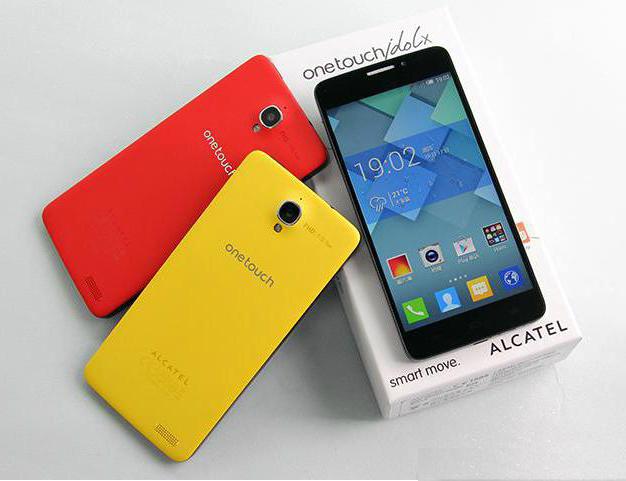
Design features
Externally Alcatel smartphone One Touch Idol X looks solid and presentable. Its body consists of straight, clear lines with slightly rounded corners. 80% of the front panel is occupied by the screen. The bezel around it is rather narrow - 2.4 mm. The only thing is that there are black stripes at the top and bottom, which serve as a place for placing important elements. For example, a "peephole" of the front camera, a standard earpiece opening, sensors are displayed above the screen. At the bottom there are three control buttons. They are sensory. And most importantly, the developers used backlighting, thanks to which, even in the dark, the keys are easily recognized.
On back cover the main camera lens flaunts at the top. There is a single-position LED flash underneath. The output speaker grill is located in the lower right corner.
As mentioned above, the Alcatel One Touch Idol X case is completely made of plastic. Thanks to this, the weight of the gadget turned out to be only 130 g with dimensions of 141 × 68 × 6.9 mm.
As for the connectors and mechanical buttons, they are located on the side faces and ends. The USB port and microphone are on the bottom, and the headphone or speaker jack is on the top. The audio jack is standard; no adapter is needed for most equipment. The lock and volume keys are displayed on the right side. 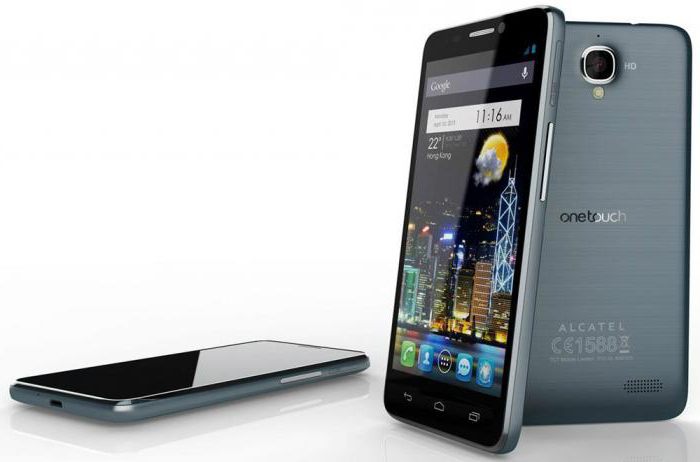
Hardware "filling"
What do most buyers look for when buying an Alcatel One Touch Idol X? Processor characteristics. This criterion is quite important, since the phone is a kind of mini-computer. The device is equipped with a MediaTek chipset, which is not bad by modern standards. It is based on four cores.
The compute modules use the basic Cortex-A7 architecture. The MT-6589T processor provides high performance, during which the core can overclock up to 1500 MHz. At the moment, in this segment, such indicators are considered quite high.
Considering that the gadget was released in 2013, it easily coped with the most difficult tasks, launching any resource-intensive applications and games. However, at the moment the only thing that is beyond his power is software, which is developed for 64-bit platforms. In this smartphone, the chipset is configured for 32-bit computing only. If the buyer sets tasks such as high-quality video display, music playback, surfing the Internet, then all of them are performed by the device flawlessly.
Graphics accelerator
An equally important indicator of the high functionality of the gadget is the video card. V this device the developers used the Power VR SGX544MP model. Three years ago, she could cope with any task. But when it comes to modern games that require high performance, the graphics accelerator simply isn't enough to run them. According to many users, at present the video card allows you to easily solve most of the tasks. The restrictions apply only to games, so you'll have to settle for mid-range applications. 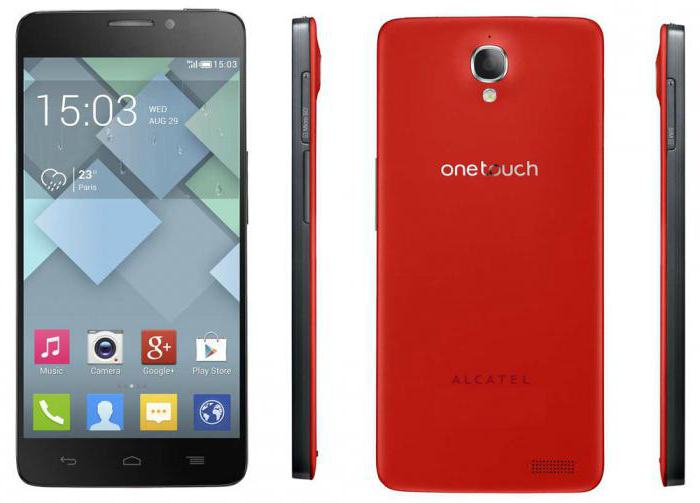
Memory
By pursuing Alcatel review One Touch Idol X, it is imperative to pay attention to the characteristics of the memory. Despite the fact that there are several modifications of this model, the developers in all used the same amount of "RAM". It is 2 GB. Initially, system processes take up about 700 MB. The rest of the storage can be used to work with additional software.
As for the integrated memory, in the modification with one SIM card, its volume is only 8 GB. The developers have provided a slot for a memory card in it. The device supports 32 GB flash drives. Models working with two SIM cards have 16 gigabytes of internal memory. This modification does not provide a slot for an external drive.
Screen features
Which image will please the Alcatel One Touch Idol X? The display is made using modern OGS technology. Thanks to her, the picture is displayed on the screen in maximum quality. There are no complaints about viewing angles, since the image is practically not distorted when tilted 180 degrees. Currently, such displays are rarely found in mid-range devices, not to mention the budget segment.
The main element of the smartphone is its 5-inch screen. The display resolution is still relevant today. Even now, there are few smartphones that can boast an indicator of 1920 × 1080 px.
To protect the screen, the manufacturer used an analogue of Gorilla Glass - Dragontrail. This is a protective glass that is not afraid of shocks and withstands mechanical stress of different levels. The presence of an oleophobic coating will also please. Thanks to it, owners will not have to constantly struggle with fingerprints.
Alcatel One Touch Idol X: camera specifications
The Idol X gadget from Alcatel also does not deserve comments in matters with optics. The main camera was manufactured according to modern technologies... It is based on a 13-megapixel sensor. Its manufacturer is a leader in this field. It's about Sony. Most buyers have already dealt with her products, leaving only positive reviews... To increase the quality were used additional functions such as flash and auto focus. This camera can be used to record videos. The speed per second does not exceed 30 frames. The maximum resolution is 1080p.
Buyers did not have much interest in the front camera, since it is equipped with a 2-megapixel matrix. It can be used mainly for video calls only. For a high-quality selfie, this resolution is no longer enough.
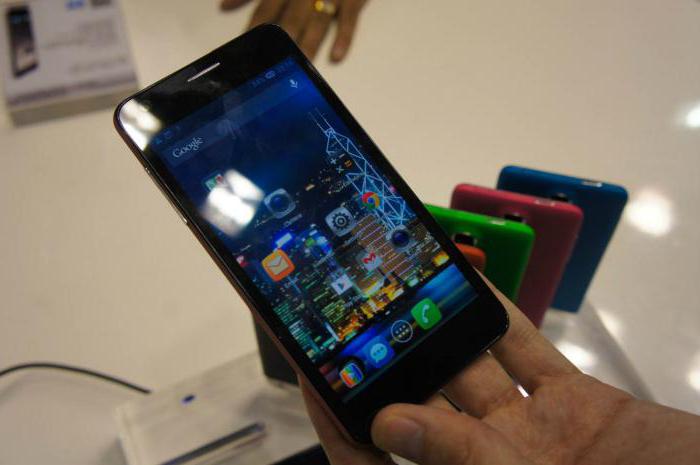
Battery specifications
All of the above characteristics can only be attributed to advantages. However, it is worth talking about weaknesses Alcatel One Touch Idol X. Battery, set by the developers, will not please the owners. Its capacity for modern requirements is scanty - only 2000 mAh. Based on lithium-ion technology. If we study the battery indicators declared by the manufacturer, then according to them, when working with second-generation networks, the device will be discharged after 320 hours, and when connected to 3G, the time will decrease by 80 hours.
Users in their reviews claim that with maximum savings, the gadget will be able to work up to 2 days. If you make the most of all its functionality, then the battery life will only last for daylight hours. All owners are encouraged to purchase external battery... Thanks to it, you can avoid situations when the battery is suddenly completely discharged at the most inopportune moment. It is important to understand that different functional processes consume the amount of energy in different ways.
Communications
Smartphone One Touch Idol X is equipped with all the necessary communications. Users are provided with Wi-Fi support as a priority method for data exchange. For wire transfer of information, it is used USB cable... The device has a connector, thanks to which you can not only charge the device, but also connect to computers, laptops and other equipment. For use wireless ways data exchange is provided by Bluetooth. You can also use a special headset with it.
3G support provides not only making calls and sending messages, but also connecting to the Internet. In this case mobile operators provide high-quality speed, thanks to which you can make video calls to the Alcatel One Touch Idol X (the front camera is intended for this purpose). The device also supports the GSM standard. It is designed for quick identification location of the device. And of course, the developers have provided the ability to connect a wired speaker system... For this, the gadget has a 3.5 mm port.
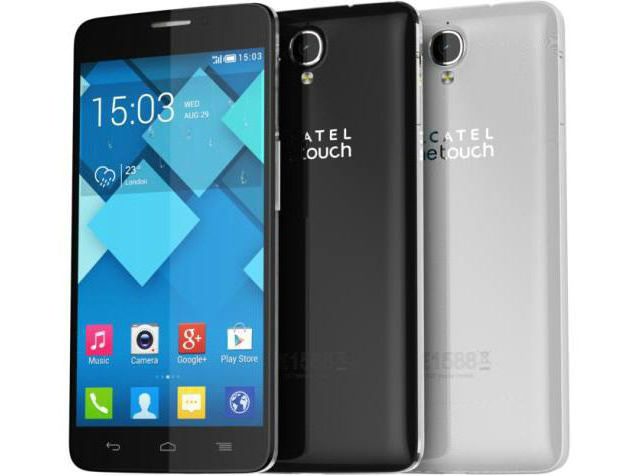
Software
As a platform, the developers used the most common operating system. It's about Android. As for the version, the device runs on a rather outdated 4.2. Many users say that this causes some inconvenience, since there are restrictions on installing applications. But if we take into account that the processor runs on a 32-bit system, then this version is quite enough to ensure the operation of many non-resource-intensive programs. All owners, without exception, can use international social media, all without exception Google services... And for the installation of additional content, there is a special Play Market store.
On top of the operating system, the manufacturer used its own proprietary shell. It provides an initial set of applications - an organizer, calendar, alarm clock, calculator and more. To expand the functionality of the gadget, the user can always download additional software from the Internet.
Problem solving
According to most users, this smartphone model boasts high level reliability. If there were any breakdowns, then they make up a very small percentage. Most often, users encounter freezes. In most cases, this is unusual for the Alcatel One Touch Idol X. The firmware of the original version usually works flawlessly. However, there are still isolated cases. To do this, users are advised to contact service center in order to update your device. The most "advanced" ones do it themselves. However, you must understand that changing the firmware yourself can lead to the complete failure of the gadget. Therefore, such actions are done at your own peril and risk.
Briefly about the price
Due to the fact that this phone model has already been discontinued, it can be purchased only from stock. As a rule, users choose online stores for this. Undoubtedly, you can make quite profitable purchases in them. However, buyers are advised to be very careful as the Idol X is very similar to the Alcatel One Touch Idol X Mini. They have the same design, however latest version somewhat inferior in characteristics and dimensions. Naturally, this is reflected in the price.
The full-fledged Idol X model launched with a cost of about $ 250 (14,000 rubles). For three years, new devices have "pushed" the smartphone to the entry-level segment. However, it is difficult to say that the Alcatel One Touch Idol X has fallen in price a lot. The price is currently about 125-150 dollars (7000-9000 rubles). Compared to competitors, in this price category there are devices that have the best technical equipment, for example, in the Sony and Xiaomi lines. 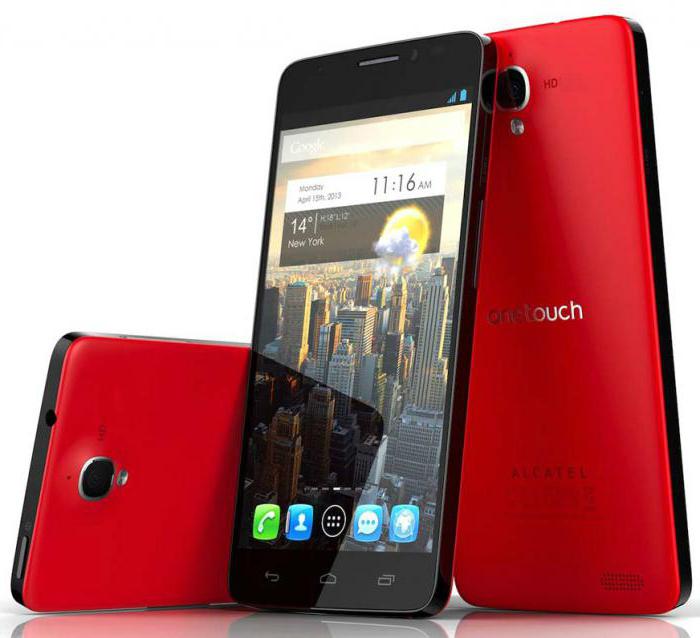
Alcatel One Touch Idol X + - Review of Another Nice Octa-Core Smartphone
22.04.2014
Lyrical introduction
A smartphone inside which eight processor cores do nothing very quickly? Not news, nothing unusual, already banal - thanks to the well-known company MediaTek.
Competitors
Well, firstly, for 15 thousand you can buy a "gray" Galaxy S4 ... Will we continue to look for competitors?
Okay, let's continue. What else do we have similar? The same screen and the same chipset.
My tests, all sorts of trivial actions such as opening pages or launching programs.
Sensors - all the main ones are there. There are no excesses - thermometers and barometers - alas, no. But here's the gyroscope, accelerometer and compass in place. Not to mention the light and proximity sensors.
Communication with the outside world
3G Internet is present, it works fine. 4G (LTE), alas, no. We look forward to when, finally, MediaTek will start churning out inexpensive LTE chips.
Wi-Fi - yes, of course. The sensitivity is good, the speed is also good, 35 Mbps squeezes out without problems. There are mentions that it is dual-band here. But something is doubtful to me. Unfortunately, I can't check it myself, I haven't started the dual-band router yet.
Of course, there is Bluetooth, where can we go without it. But there is no NFC.
Connecting to a computer via USB - only in MTP mode. There is no ideologically correct Mass Storage.
There is no possibility of connecting external devices (USB-OTG).
There is also no possibility of outputting a signal to a TV or monitor (MHL or HDMI) via a wire. But there is a "Wireless Screen", that is, Miracast - ie. you can output a signal to a TV without wires (if, of course, the TV supports this technology).
Screen
Five-inch IPS-screen with a resolution of 1080x1920 pixels (i.e. FullHD).
The screen deserves extremely warm words. Very high quality, very slippery, excellent viewing angles, oleophobic coating, decent behavior in the sun. Not greedy, what can I say.
The sensor is also completely problem-free, clear. Ten simultaneous touches.
The maximum brightness is under 400 cd / m2 with a contrast ratio of 770: 1. Excellent result. Sometimes I met screens that were both brighter (Huawei Honor 3) and more contrasting (Sony Xperia Z Ultra), but not often, quite infrequently.
It is possible to adjust the white point in the range from 6100K to 7000K (British scientists consider 6700K as ideal). There is a possibility to adjust the color saturation. What's funny is that the photograph, which is used to judge how the colors change with such adjustments, shows something suspiciously reminiscent of an orange-eared Zaporozhets.
Color gamut - 98% sRGB.
Operating system and other software
The smartphone is operating system Android 4.2.2 Jelly Bean, on top of which Alcatel has perched its proprietary shell. It turned out beautifully, but strange in some places. For example, the leftmost screen - what is it? Picture viewer? Why does he need a separate screen? It seems to be not suitable for anything but pictures.
Second screen. Also unusual. "Wall of widgets". It can be only widgets. Those. widgets can be on any screen in general, but on the second screen there can be only them, there can be no application shortcuts. Why??? Mysterious Chinese soul. Fortunately, the first two screens can be safely hidden so as not to get confused. You can admire the first or second screens in the video "Demonstration of work".
The rest of the proprietary shell is pretty common. Labels, daddies, etc. Mobile-Review says that there is no general list of all applications. At the same time, they have a specific icon (bottom right, four by four squares) in the screenshots. So that's it. I have it too. And lives behind her full list all applications.
Well, so - Android and Android. Nothing unusual.
A mountain of pre-installed third party applications... Fortunately, almost everything can be removed without any problems. Except for Deezer, Facebook and Flashlight. For some reason, these three received the status of the inviolable.
Battery
The battery capacity, although not a record one, is not bad - 2500 mAh. On average, according to my numerous battery tests, it is 125% of the Galaxy S4 results. Very worthy.
Full charge time is average charger(5V, 1A) - a little less than three hours.
The device can shoot video in "full HD", 30 frames per second. The quality is reasonable, examples are in front of you.
Colour
Determining the type of device (phone or smartphone?) Is quite simple. If you need a simple and inexpensive device for calls and SMS, it is recommended to opt for a telephone. A smartphone is more expensive, but it offers a wide variety of options: games, videos, the Internet, thousands of programs for all occasions. However, its battery life is significantly shorter than that of a simple phone.General characteristics
Type of
Screen
Screen type color IPS, 16.78 million colors, touch Type of touch screen multitouch, capacitive Diagonal 5 inches. Image size 1920x1080 Pixels Per Inch (PPI) 441 Automatic screen rotation there is Scratch resistant glass there isMultimedia capabilities
Rear camera 13.1 MP Flash rear, LED Rear camera functions autofocus Video recording there is Max. video resolution 1920x1080 Max. video frame rate 30 frames / s Front-camera yes, 2 million pixels. Audio MP3, AAC, FM radioConnection
Standard
There are several basic standards cellular that are supported by modern phones. On the territory of Russia, the GSM standard is used almost everywhere. For high-speed data transmission, 3G and 4G LTE standards are used - the highest speed of the existing standards. Glossary of Terms for the Mobile Phones Category
GSM 900/1800/1900, 3G Interfaces
Almost all modern smartphones have Wi-Fi and USB interfaces. Bluetooth and IRDA are less common. Wi-Fi is used to connect to the internet. USB is used to connect the phone to a computer. Many phones also have Bluetooth. It is used to connect wireless headphone, to connect the phone to wireless speakers as well as for transferring files. A smartphone equipped with an IRDA interface can be used as universal remote control Remote Control Glossary of Terms by Category Mobile Phones
Wi-Fi 802.11n, Wi-Fi Direct, Bluetooth 4.0, USB Satellite navigation
Built-in GPS modules and GLONASS allow you to determine the coordinates of the phone using signals from satellites. In the absence of GPS modern smartphone can determine its own location based on signals from base stations cellular operator... However, finding coordinates based on signals from satellites is usually much more accurate.
GPS A-GPS system yes DLNA support yesMemory and processor
CPU
V modern telephones and smartphones usually use special processors - SoC (System on Chip, system on a chip), which, in addition to the processor itself, are located graphics core, memory controller, controller of input-output devices, etc. Therefore, the processor largely determines the set of functions and performance of the device. Glossary of terms for the category Mobile phones
2000 MHz Number of processor cores 8 Built-in memory
Built-in memory is used to store programs, music, photos, movies. The amount of built-in memory largely determines the cost of the device. If your phone does not have a memory card slot, then it is recommended that you select the model with more internal memory.
16 GB The amount of memory available to the user 12.30 GB RAM size 2 GB
